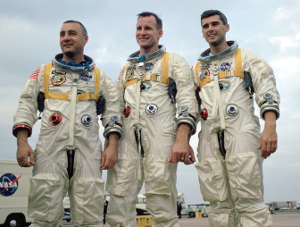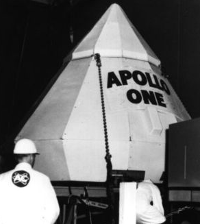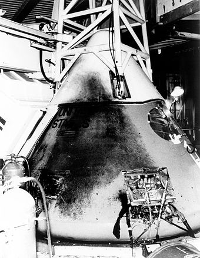Apollo 1 was the first of the Moon-focused Apollo missions. It ended in tragedy, after a fire in the command module killed all three astronauts onboard. 
The mission, the first to reach the testing stage after the successes of Project Mercury and Project Gemini on the way to President John F. Kennedy's stating goal of landing on the Moon and returning safely to Earth by the end of the 1960s, was originally called Apollo-Saturn 204, or AS-204 or Apollo 204. It was only after the launch pad incident that the mission was termed Apollo 1. The original crew of Apollo 1, as assigned by Director of Flight Crew Operations Deke Slayton, was Mercury and Gemini veteran Gus Grissom (above, left) as Command Pilot, Gemini veteran Ed White (above, center) as Senior Pilot, and rookie Donn Eisele as Pilot. Gemini communications veteran Roger Chaffee (above, right) replaced Eisele when the latter dislocated his shoulder during weightlessness training. The launch date was Feb. 21, 1967. The target time for the mission was two weeks. 
The incident occurred on January 27, a little more than three weeks before launch. It was just an exercise, a "plugs-out" test, a run-through for the spacecraft with all of the cables and umbilicals removed. The test was not a new thing: Scientists had performed numerous such tests for both Mercury and Gemini. The "plugs-out" test was classified as nonhazardous the spacecraft had no fuel or cryogenics in it. Further, any explosive bolts had been removed. Inside the command module, the atmosphere was 100 percent oxygen. Some scientists had suggested that the atmosphere be a mix of nitrogen and oxygen, much as the air that people breathe every day. However, fresh in the minds of organizers was the experience of test pilot G.B. North, who, while testing a Mercury atmosphere system, had gone unconscious and seriously hurt himself because the atmosphere was too high in nitrogen. As well, thinking ahead to the Moon, NASA wanted to streamline the breathing protocol of the astronauts with regard to their spacesuits, and a pure oxygen atmosphere made this process faster than did a nitrogen-oxygen mix. The Apollo spacecraft had in its design a target pressure of 5 psi (pressure per square inch), the same as that in space. The test was conducted not in space but on the ground, where pressure starts at 14.7 psi. Scientists cranked the pressure up even further for the test, to 16.7 psi. The downside of that pressure level was that it made clothing and metals highly prone to catching fire and burning. The hatch was designed to be opened slowly and by hand. Designers were mindful of the hatch door of Grissom's Project Mercury flight, which had opened on its own, putting the astronaut in jeopardy. The door was designed for the pressure inside the capsule to be higher than the pressure outside and for the astronauts, should they need to open the hatch, to overcome that pressure disparity by accessing a valve that would vent the inside pressure. The test had begun at 1 p.m. Grissom had complained of a strange small after he had hooked up his oxygen supply; no one could explain the cause of the smell, and preparations continued. In a related problem, the high flow of oxygen more than once set off the master alarm. No one was able to solve the problem and nothing really seemed to be the matter, so NASA and the astronauts decided to ignore the alarm. Problems with communications systems dogged the first few hours of testing. At 5:40 p.m., NASA officials called a timeout in a last attempt to sort out the comm system. 
At 6:31 p.m., fire broke out inside the capsule. All three astronauts succumbed to smoke inhalation and passed out; they died in the fire, largely because of high concentrations of carbon monoxide, the results of the blaze. The pressure level in the capsule had effectively sealed the door shut; as well, the valve that astronauts were to use to vent that inside pressure was obscured by white-hot flames. The oxygen-rich fire had increased the pressure to 29 psi, shattering the inner wall of the capsule. The fire was in danger of spreading upwards, to the launch escape system and then to the whole structure on top. Because the test was deemed nonhazardous, a contingent of fire, rescue, and medical teams was not standing by. A host of firefighters who had been quickly mobilized and who raced to the scene did what they could, but it was too late. They did succeed in containing the fire. Chafee, Grissom, and White were mourned nationwide. Condolences came in from around the world. Many questioned the wisdom of continuing the space program. NASA Administrator James Webb instituted a review, and an extremely thorough investigation followed. Through intensive testing and reconstruction of the events that led to the fire, scientists discovered that a spark in a wire bundle had started the fire and that the fire had fed hungrily on the oxygen-rich atmosphere inside the spacecraft. The investigation also discovered that inside the spacecraft were large amounts of Velcro, which the astronauts had asked to be removed because they considered it to be too much of a fire risk and had indeed been removed but had put back in at a later date. The U.S. Senate also conducted its own investigation and released its own findings and recommendations. That investigation uncovered some internal documents of which NASA officials were not aware. NASA stopped Apollo flights for nearly two years while they installed new systems in order to prevent the recurrence of the fatal problems and conducted exhausting testing on the command module in order to anticipate future problems and develop possible mitigations against them. Meanwhile, unmanned testing of both the Saturn V rocket and the lunar module continued. Among the changes made after the accident were these:

Chaffee and Grissom were buried at Arlington National Cemetery. White was buried at West Point. The crews of Apollo 11 and Apollo 15 left a patch and a plaque, respectively, containing the names of the Apollo 1 crew. The launch complex at which the Apollo 1 fire occurred was used once more, for the Apollo 7 launch, and then dismantled. Plaques commemorating the Apollo 1 crew remain at the site. The names Chaffee, Grissom, and White appear as part of the names for streets, schools and other buildings, and planetariums nationwide. |
|
Social Studies for Kids
copyright 2002–2025
David White




